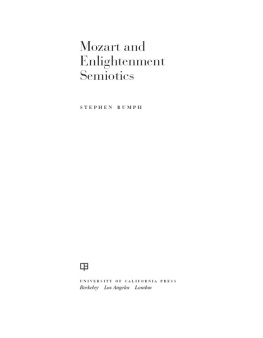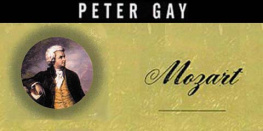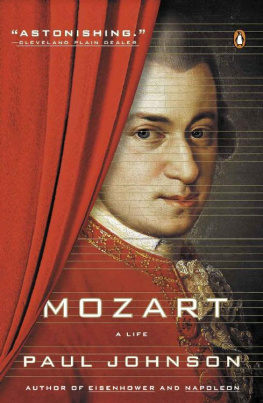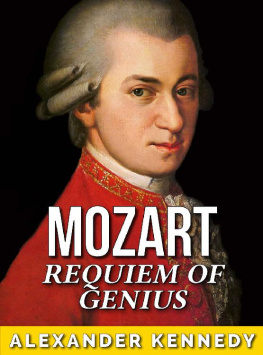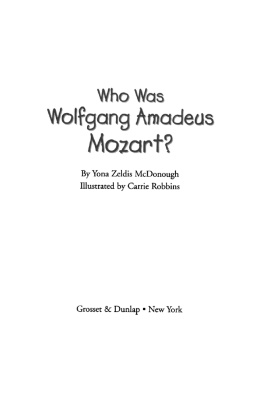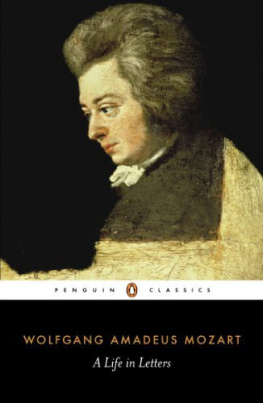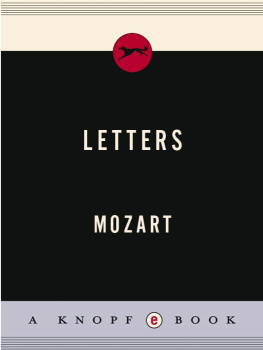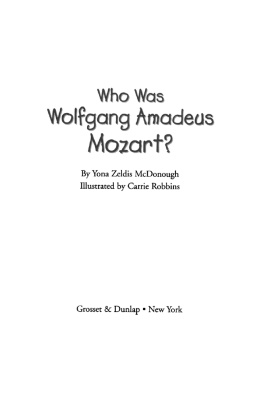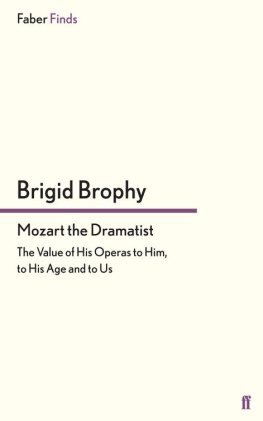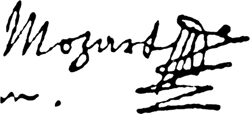
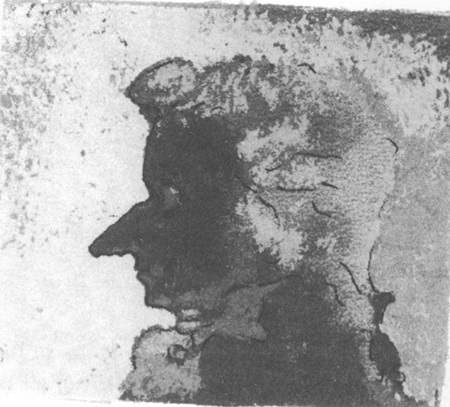
MOZARTIANA
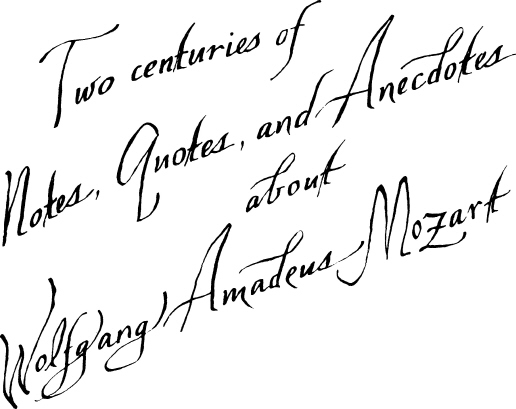
COLLECTED AND ILLUSTRATED BY
JOSEPH SOLMAN

Copyright 1990 by Joseph Solman
All rights reserved. No part of this book may be reproduced or transmitted in any form or by any means, electronic or mechanical, including photocopying, recording, or by any information storage and retrieval system, without permission in writing from the Publisher.
First published in the United Kingdom in 1991 by Macmillan London Limited; first published in the United States of America in 1990 by Vintage Books, New York; first paperback edition published in 2002 by Walker Publishing Company, Inc.
Published simultaneously in Canada by Fitzhenry and
Whiteside, Markham, Ontario L3R 4T8
For information about permission to reproduce selections from this book, write to Permissions, Walker & Company, 435 Hudson Street, New York, New York 10014
Library of Congress Cataloging-in-Publication Data
Mozartiana : two centuries of notes, quotes, and anecdotes about Wolfgang Amadeus Mozart / collected and illustrated by Joseph Solman.
p. cm.
eISBN 978-0-802-71911-9
1. Mozart, Wolfgang Amadeus, 1756-1791Anecdotes. I. Solman, Joseph, 1909
ML410.M9 M78 2002
780'.92dc21
2002016773
Visit Walker & Company's Web site at www.walkerbooks.com
Printed in Canada
2 4 6 8 10 9 7 5 3
It may be that when the angels go about their task praising God, they play only Bach. I am sure, however, that when they are together en famille they play Mozart.
KARL BARTH
CONTENTS
A Man, Just Like You
WOLFGANG AMADEUS
Really a Good Fellow
MOZART'S CONTEMPORARIES
Changing Their Minds
THE CHANGING VIEW OF MOZART
From Your Wisdom
COMPOSERS ON MOZART
Bravo!
PERFORMERS ON MOZART
Spoken with Authority
ARTISTS AND CRITICS ON MOZART
Hear the Musicians
INSTRUMENTAL WORKS
Now for the Serenade
THE OPERAS
Requiem
LAST DAYS
MOZARTIANA
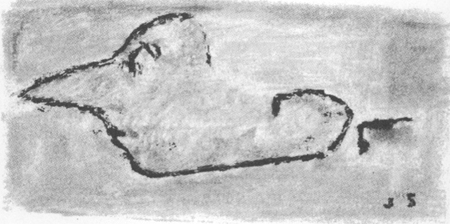
Sometime in the winter of 1930, a roommate who shared a studio apartment with my brother and me bought a recording of Mozart's Piano Concerto in G, K. 453. From the moment we put it on the battered, rickety Victrola, we all became entranced with its fluid beauty. It quickly replaced the well-worn Appassionata sonata of Beethoven as our daily religious service.
A great and growing passion for the instrumental music of Mozart ultimately led me to his operas. In the years following 1934, when John Christie began the Glyndebourne Festival in Sussex, recordings of Mozart's operatic works became popular with music lovers and radio stationsso much so that I found I could paint all afternoon listening to the sounds of The Magic Flute and Figaro, the music from the radio filling the room as the broad brush strokes of my street scenes filled the canvas.
As I became thus absorbed in his music, I decided to try a modern portrait of my idol. I checked the complete iconography of Mozart but soon discovered that the public craving for idealization of its great men had caused innumerable hacks to transform Mozart into a fair-haired Greek god. There were twenty-six portraits in all, most of them spurious, and no two seemed to give the same impression of what Wolfgang Mozart actually looked like. I did find a drawing from life done in 1789 by one Dora Stock that impressed me with its veracity and honesty. The jutting profile, the prominent nose, a soft, sensuous mouth with a hint of irony wrinkling it, a slightness of statureall were there, a visual replica of the contemporary descriptions of Mozart that I'd read.
Using this portrait as my point of departure, I began making a number of sketches in pencil and watercolor. These, presented here in black-and-white, I offer as a kind of visual commentary on the many statements and stories about Mozart that I have collected over the years. In assembling them for this book I have discovered that reactions to Mozart are as abundant and unexpected as the rich variety found in the music itself. And the volume and fervor of these reactions are (at least to this surveyor) absolutely unparalleled in Western music and, with the possible exception of Shakespeare, in Western art.
For me, Mozart's music represents neither the prolonged sigh of faith that characterizes so much of the music written before his time, nor the stormy idealism which cloaks most music after him. Rather, he is that mercurial balance of the skeptic and the humane. Like him, and in him, we can always discover new worlds.
JOSEPH SOLMAN
New York City
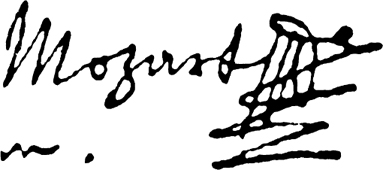

TAMINO: Tell me who you are, my jolly friend.
PAPAGENO: Who am I? Silly question! A man, just like you!
Sunday, January 27, 1756, 9 Getreidegasse, Salzburg, 8 P.M. A little boy is born to the violinist-composer Leopold Mozart and his wife, Anna Maria. One day later, the child is christened Johannes Chrysostomus Wolfgangus Theophilus Mozart. Chrysostomus ("Golden mouth") is rarely used; Theophilus becomes Gottlieb in German and Amadeus in Latin. Sigismundus is later addedperhaps to honor the archbishop of the city, the father's patron and employer.
He was a remarkably small man, very thin and pale, with a profusion of fine fair hair of which he was rather vain. He gave me a cordial invitation to his house, of which I availed myself, and passed a great part of my time there. He always received me with kindness and hospitality. He was remarkably fond of punch, of which beverage I have seen him take copious draughts. He was also fond of billiards and had an excellent billiard table in his house. Many and many a game have I played with him, but always came off second best. He gave Sunday concerts at which I was never missing. He was kind-hearted and always ready to oblige, but so very particular when he played that if the slightest noise were made, he instantly left off.
MICHAEL KELLY, the first
Basilio in The Marriage of
Figaro, in his Reminiscences
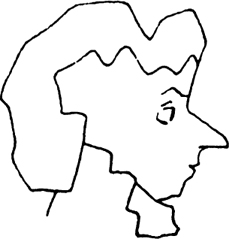
My brother was a rather pretty child.
MARIA ANNA "NANNERL"
MOZART, Wolfgang's sister,
in a letter, 1799
Your countenance... was so grave that many intelligent persons, seeing your talent so early developed and your face always serious and thoughtful, were concerned for the length of your life.
LEOPOLD MOZART, in a letter
to his son
Next page


